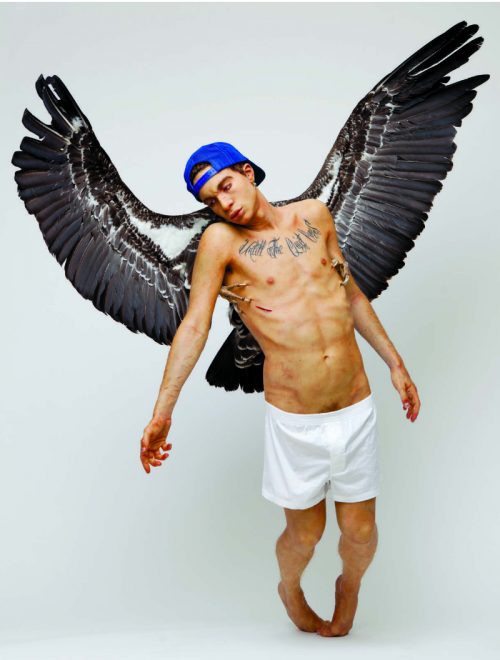WE belIeve in:
the kid
Voice of a Generation Through Art and Memory

“…But the civilization of the spectacle is cruel, because the spectators have no memory. Because of that, they also lack remorse and true conscience.”
This quote comes from the Mexican poet, Octavio Paz, during a conference and later on in his compilation book Chiapas: hechos, dichos y gestos. However, the Mexican Nobel Prize Winner was mistaken and so is Mario Vargas Llosa who quoted him in his essay Civilization of the Spectacle, along with a handful of critics, for we do not suffer from amnesia but rather from hyperthymesia. In an effort to highlight and perhaps to alleviate the weight of crimes inherited from past generations, young artists such as The Kid, combine different iconographies in order to grasp the future of a seemingly lost generation and to find a sense of reason amongst the rubble.
The Kid’s work embodies Aby Warburg’s Mnémosyne Atlas, a project where the philosopher tries to find coherence in forms and gestures rather than in the work of art context. Hence, The Kid’s iconography navigates through time and elderly images of emotional power, such as the Laöcoon, that then cohabits with modern symbols of youth. For instance, his sculpture Rise And Rise Again Until Lambs Become Lions, which works as a mnemonic trigger, as the spectator recognizes Michelangelo’s Pietà in the position of the young man’s body, hand gesture and his gaze. Blessed Is The Lamb Whose Blood Flows, is a sculpture where a modern ephebe is being carried out by an eagle and reminds us of the ancient myth of Icare. All this “ancient” iconography is relocated and transformed rendering his sculptures and drawings timeless pieces of art where all sorts of temporalities meet.

Moreover, the despair in the teenagers’ faces reveals something deeply rooted in this generation. Again, in his sculpture Rise And Rise Again Until Lambs Become Lions, the Virgin Mary figure is replaced by an animal, a fierce lion who is lying down next to the adolescent. As A Flower Chooses Its Color is another sculpture where a woman is giving birth to a baby who has tattoos all over his head. This represents social determinism and presumably intends to dismantle the so called “American dream” where supposedly everything is possible through hard work and perseverance.
The Kid adheres to the ideology of American writers such as Ernest Hemingway, Scott Fitzgerald and even Philip Roth, who question this image of perfection in American society that has now been adopted all over the world. His interest in the younger generation finds an echo in independent filmmakers such as Larry Clark, Gus Van Sant and Harmony Korine where they portray an adolescence marked by rebellion and angst against their elders and authority. The artist doesn’t hesitate to show his disapproval and disdain for the educational system and compares it to a totalitarian regime where individuals are forced to act and think alike. Anti- heroes and lost souls are the central subject of this young artist’s works, young teenagers discouraged by the world are forgotton. To some viewers his work aesthetics can be disturbing and provocative; like those of the video artist Chris Cunningham.
Although all these references emerge from The Kid’s sculptures and drawings, a less informed spectator can still feel drawn to his work by the masterfulness of his technique in both art forms, a masterfulness that amazes every viewer. I Go Alone, a huge canvas depicting two young boys, was paint- ed using egg tempera, which has the effect of mak- ing it look more like a photograph than a painting. In one of the paintings in his series I Go Alone, the young mens’ faces and range of colours remind us of the brushstrokes used by Egon Schiele in his work Seated Woman With Bent Knee.

Despite the Kid’s seemingly gloomy vision, “death shall have no dominion” for art shall save us all, art is more than just a mere visual exercise. It beomes an activity enabling action and change. This is illustrated by the fact that most of the money earned from The Kid’s art is given to Humans Rights Watch, a non-governmental organization helping young children in prisons and thereby chal- lenging the current social standards.
Through The Kid’s work, a generation, for a long time neglected and despised, finds at last a thunderous voice. The Kid is capable of seizing our dreams and shaping them. In every piece of his art, the artist reveals a powerful masterfulness that will create an entire universe according to his wishes. Like the great couture designer Alexander McQueen, he intends to build a whole universe in every exhibition or show, into which the spectator will be dragged and almost forced to experience art differently. By combining all epochs and categories, The Kid appears determined to produce and all-embracing art form or a modern “gesamtkunstwerk”, where music, sculpture and video will come together as a whole.